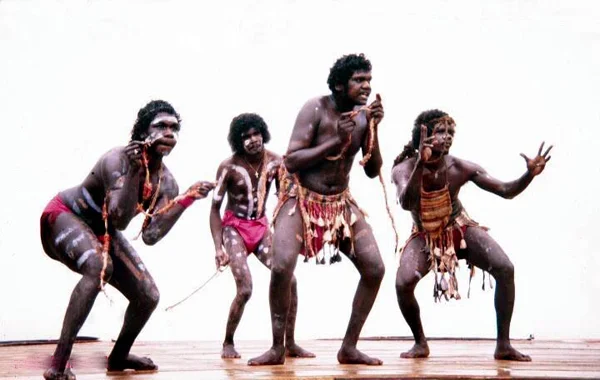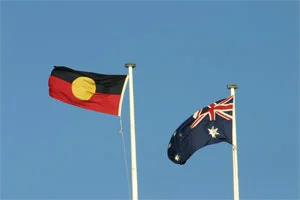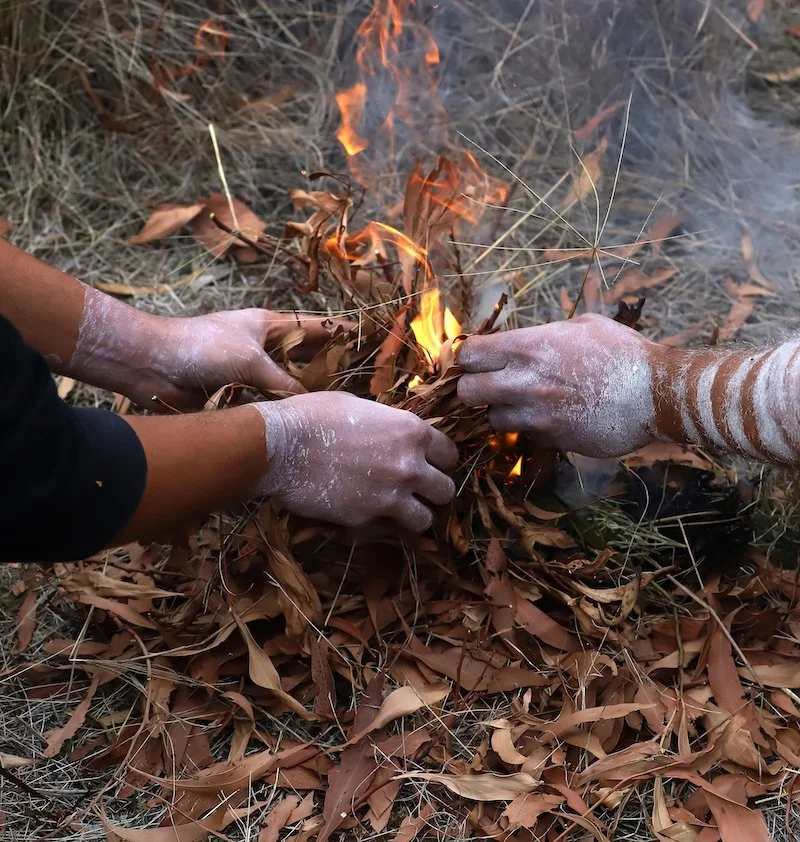The first people to live on this land were the Aboriginal peoples.
They are the First Nation People and many groups lived all over the land.
They have lived here for tens of thousands of years.
Some groups settled on islands nearby and have become known as Torres Strait Islander people.
There were hundreds of languages because each group had its own.
We acknowledge and pay respect to the Traditional Custodians of this continent and to their Elders, past, present and emerging.
The Aboriginal Flag flying next to the Australian national flag
Australia's first inhabitants
Aboriginal people had already inhabited the Australian continent for about 50 000 – 60 000 years before European settlement.
These First Nations completely occupied the continent. Different groups had separate countries and they moved through their territory on foot, making pathways beside streams and rivers, or between water-holes. There were hundreds of languages and many nations. Some groups of people settled on the islands in the Torres Strait and are known as Torres Strait Islander people. Today they have their own flag, just as the Aboriginal peoples of the mainland have theirs.
Read about both flags and their meanings
Look at a map of the continent showing where the Indigenous groups lived:
https://digital-classroom.nma.gov.au/images/map-indigenous-australia
People of different groups asked permission if they were wanting to pass through another group’s territory, or country. As they crossed the country of neighbouring groups they carried message sticks. These Islanders and the Aboriginal people in Northern Australia made rafts and canoes and travelled across rivers and across the sea. Some Aboriginal people travelled south and crossed into the land we now call Tasmania, (Tasmania was joined to the mainland of Australia until about 14 000 years ago) which became separated from the mainland when the sea level rose.
How did First Nations People live?
Australian Aboriginal peoples were hunters and ate the animals they caught, they were also gatherers of plants that could be eaten. They also had a complicated system of land management and farming. They used fire as part of their farming practices. At certain times, areas were set on fire in particular ways so that the burning was controlled and confined so that a huge bushfire wasn’t created. There are many Australian plants that drop seeds only after fire, and the soil after fire is enriched by the ash. New shoots grow quickly after a fire, attracting animals such as kangaroos, some of which were hunted and eaten.
First Nations People have a strong connection to country, the traditional land of their nation, as well as the importance of the land, ocean, river and inland waters. The people who lived along the coast or rivers caught and ate fish. Traditional methods of fishing were passed down through generations. Fishing with lines and nets made from tree bark and grasses was traditionally done by women, who paddled out in canoes to catch fish. Men used long, pointed spears and waded out into the water to spear fish. There is evidence of fish traps, an early form of fish-farming (aquaculture): there are remains of systems of channels that grew narrower until fish, including eels, were trapped in pools. The oldest fish and eel trapping system ever found can be seen in Western Victoria, Australia - the Budj Bim fish trapping system of the Gunditjmara people.
Read more about Budj Bim and see a video and pictures.
In many parts of Australia there are actually more than four seasons, which was a European system. Because of the various climates and seasonal changes, groups moved across their territory or country accordingly, so that they arrived in places at times when certain foods were ripe and ready for picking, or hatching (such as Bogong moths) or at a good time for eating. They built shelters that were different in design depending on the climate (the weather), and the season in their part of the continent.
First Nation peoples had a variety of tools for digging, cutting and for hunting. Spears, spear throwers and boomerangs were used for hunting and as weapons. There were different shapes suited according to purpose. They built canoes and other kinds of watercraft from bark. Nets, baskets and bags were made from different fibres and from animal skins. Clothing too, made out of animal skins, varied depending on the weather and the season.
Read about the tools and technology of First Nations People
https://www.aboriginalculture.com.au/weapons.html
Those groups that lived in the north traded with people who lived in New Guinea and with visiting sailors and fishermen from parts of what is now Indonesia.
An ancient rock painting Getty Images
As well as language, each First Nation community has its history, customs, laws and beliefs, called songlines. These were known and taught by respected older members of the group, known as Elders. To become an Elder, a person had to know all the songlines of their nation. Through storytelling, dances, paintings, they passed on their history to each new generation. As a term of respect, Elders are known as Aunty or Uncle.
It’s a good idea to use more than one source for your information:
Watch a video about a young First Nations artist as he explains about Aboriginal art
https://www.youtube.com/watch?v=ZejfaAhmiEI
Read about the Dreaming: the time of creation
http://www.indigenousaustralia.info/the-dreaming/introduction.html
Go here for more information about Australia’s First Nations People.
http://australianmuseum.net.au/indigenous-australia
Welcome to Country, Acknowledgement of Country
Today in Australia, First Nations people are acknowledged as being the original custodians, or people who looked after the lands, on which they lived. There are signs in public buildings and speeches generally begin with an Acknowledgement similar to this:
We acknowledge and pay respect to the Traditional Custodians of this land and to their Elders, past, present and emerging.
The words are different if spoken on the land of a particular group, in which case the group is named.
Sometimes at an event or when a speech is being made, an Aboriginal Elder of the group on whose land it is held will begin the proceedings by making a speech called Welcome to Country. Sometimes a smoking ceremony might be held: some groups traditionally burned native leaves such as eucalypt to produce smoke that was to cleanse and protect the spirits of those entering the country. As part of the ceremony people step closer and let the smoke ‘wash’ over them, and sometimes lift each foot so the smoke cleanses the soles.
Making a fire is the beginning of a Smoking Ceremony. Image ©iStock
Watch a video of a book by Aunty Joy Murphy, a respected Wurundjeri Elder, about the words of welcome of the Wurundjeri People.
What’s the difference?
A Welcome to Country is given by an Aboriginal person who is a person, usually an Elder, of the group who traditionally lived on and cared for the land on which an event is held.
An Acknowledgement of Country is a mark of respect by non Aboriginal people for the people who traditionally lived on the land and for their Elders right back through history, those who are Elders today and those who will become Elders in the future.
Music and dance of Aboriginal Australians
The didgeridoo (sometimes spelled didjeridu) may be the world’s oldest wind instrument. It is used to accompany songs and dances. Made from hollowed out tree branches a didgeridoo is about 1.3 metres long.
Here's a GREAT video of images of Aboriginal people in the present and in the past, their country, and the sound of the didgeridoo.
Go here to read more about the didgeridoo
Stories are told through dance and music
iStock/Getty






